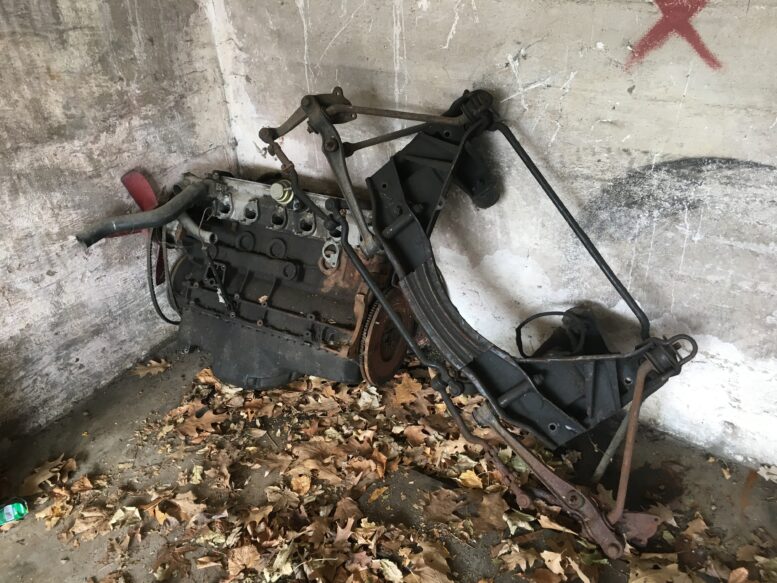A few weeks ago, I wrote about the issue of what to do with the numbers-matching engine I pulled from my ’73 E9 3.0CSi 35 years ago. This isn’t a hypothetical question, as it’s been sitting in the garage of what was my mother’s house in Brighton ever since, and the time has come to deal with it and other long-immobile sins of the past.
One of those has actually been in the garage longer than the engine—an entire front subframe from a wrecked rusty 2800CS I purchased and parted out shortly after I bought my E9 in 1986. This was a much easier issue to deal with than the numbers-matching engine. First, there isn’t the same you’ll-regret-it-if-you-toss-it argument. Second, unlike the engine, I already knew what I’d do with it—strip off the parts I want to keep and offer the bare subframe for free to anyone local who wants it. Lastly, the mechanics of moving it are much simpler. Although the loaded subframe assembly certainly isn’t light (that steering box alone is a moose), I figured that I could rig up a wooden ramp and use my Warn PullzAll winch to pull the assembly up and into the back of the truck. My plan was to strip it right there, offer it up, then drop it at the local recycling depot if there were no takers.
So this past Friday, I pulled the trigger on Operation Subframe. I loaded up the PullzAll, an extension cord, a moving dolly, and a heavy-duty ratchet strap in the back of the truck, and headed for Brighton.
I thought I could position the truck directly in front of the garage and simply drag the subframe straight into the utility body, but the truck stuck out too far into the street, so I had to do it in two steps. I’m very mindful of re-injuring my partially-healed back, so I was glad that the subframe had been stored largely upright, enabling me to basically tip it over onto the dolly. I rolled it out into the street, then set up a ramp into the back of the truck using some scrap wood that, coincidentally, I found standing right next to the engine and subframe.
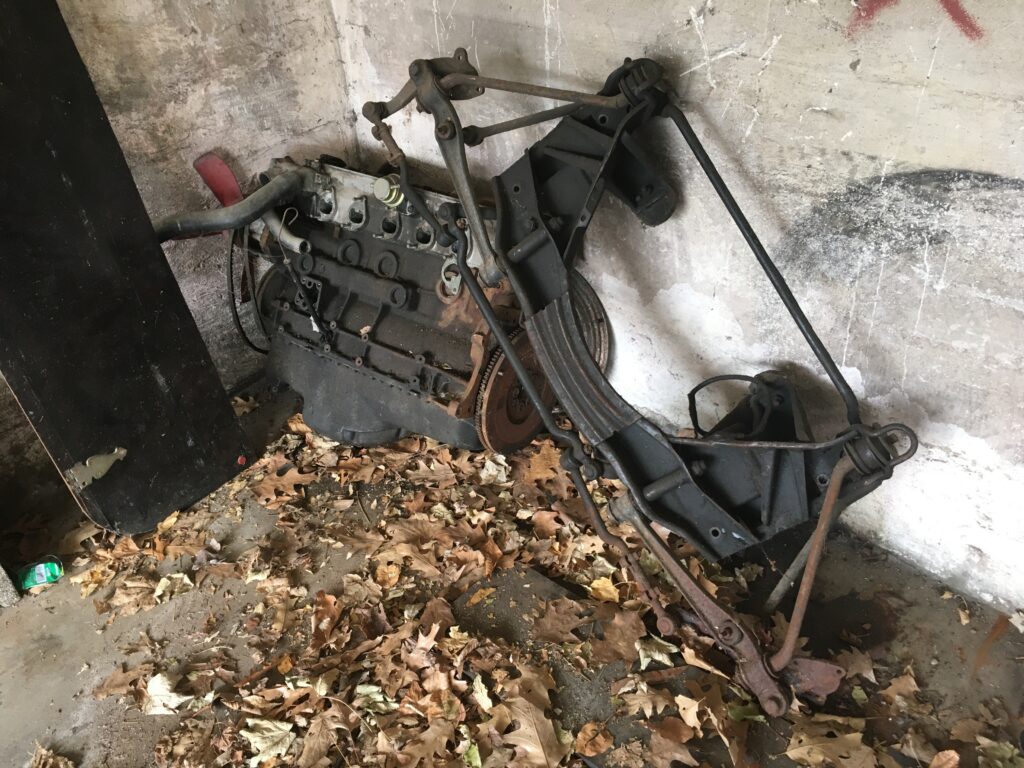
It’s as if that black ramp had been waiting there for me.
I had a little bit of a surprise when I realized that there was no good place in the back of the truck to anchor the PullzAll (there are no tie-down hooks back there), but I managed to stretch the ratchet strap between the two rows of the utility body’s shelves and hook the PullzAll to it. I wouldn’t want to try to drag the 350-pound engine up and in that way, but the subframe felt under control.
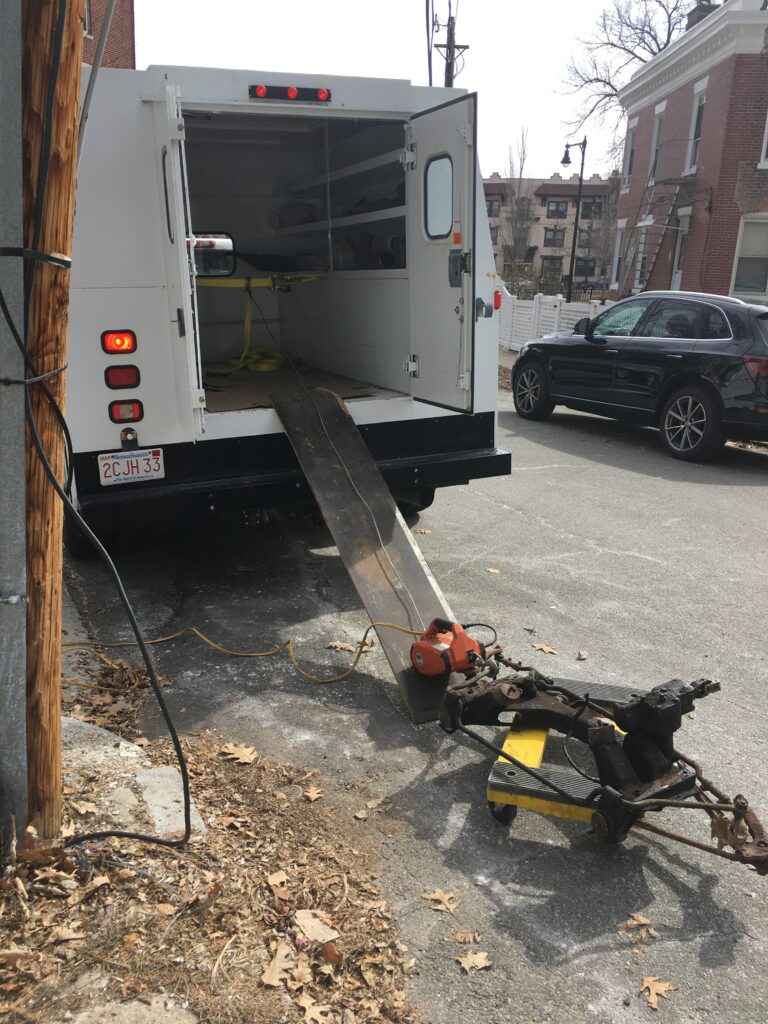
Up and in ya go.

Yeah, I kind of made this part up as I went along.
I headed home, backed the truck into my driveway, fired up the compressor, and stretched the air hose out to the utility body to give my beat-up 64-year-old self the benefit of using an impact wrench for the disassembly. Still, I didn’t expect this to be easy, and it wasn’t. I soon had quite a selection of tools back there, and threw everything I had at separating the subframe from its components.
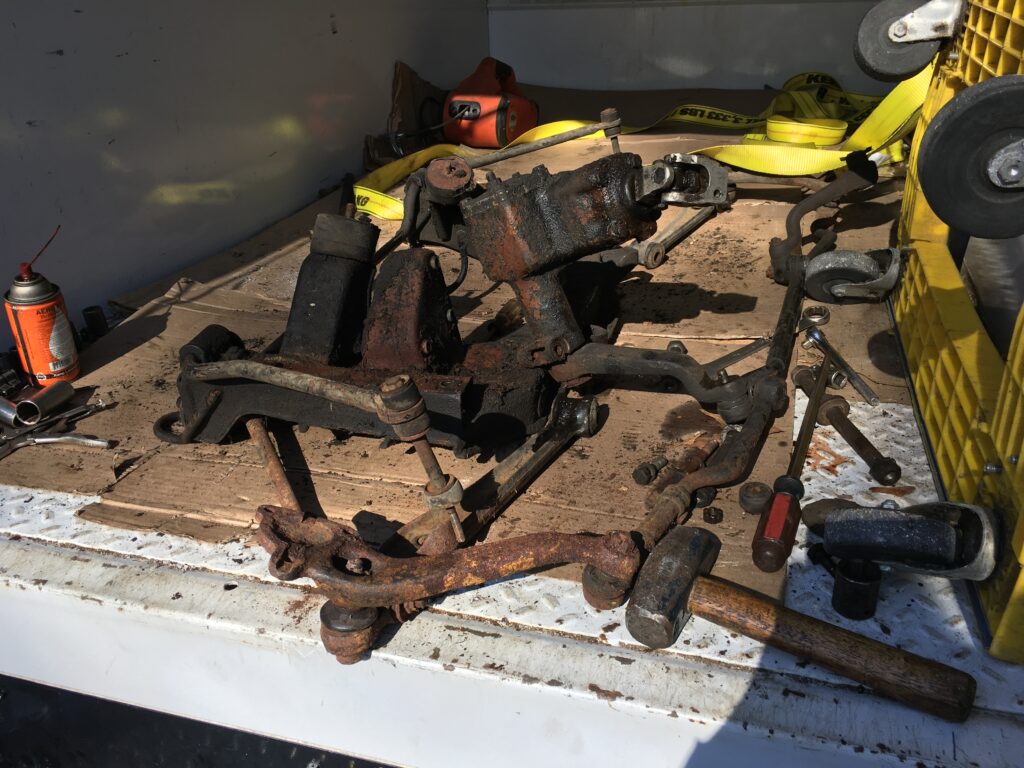
The full-on assault. It ain’t disassembly without a big hammer and a can of SiliKroil.
The big 24-mm bolts and nuts securing the control arms came out surprisingly easily. Even the tapered shaft connecting the center track rod to the arm coming down from the steering box popped off with dignity and grace when pressed by the puller. The bear turned out to be one of the radius rods (the dog-leg pieces connecting the subframe with the ends of the lower control arms). The 22-mm nut on the back of it wouldn’t come off despite my using so much heat that the burning rubber bushing filled the back of the truck with smoke. The nut did come off the front, but the rod was seized in the steel sleeve that runs through the center of the big rubber bushing. I eventually got it out by slicing the bushing and putting a lot of leverage on the rod from behind with a crowbar, pulling the rod through the bushing with the metal sleeve still on it. Finally the tangled-spaghetti-like chain of steering components—knuckle, radius rod, lower control arm, tie rod, and center link connecting to the mirror-image assembly on the other side—broke free of the subframe and slithered out the back of the truck onto the asphalt.
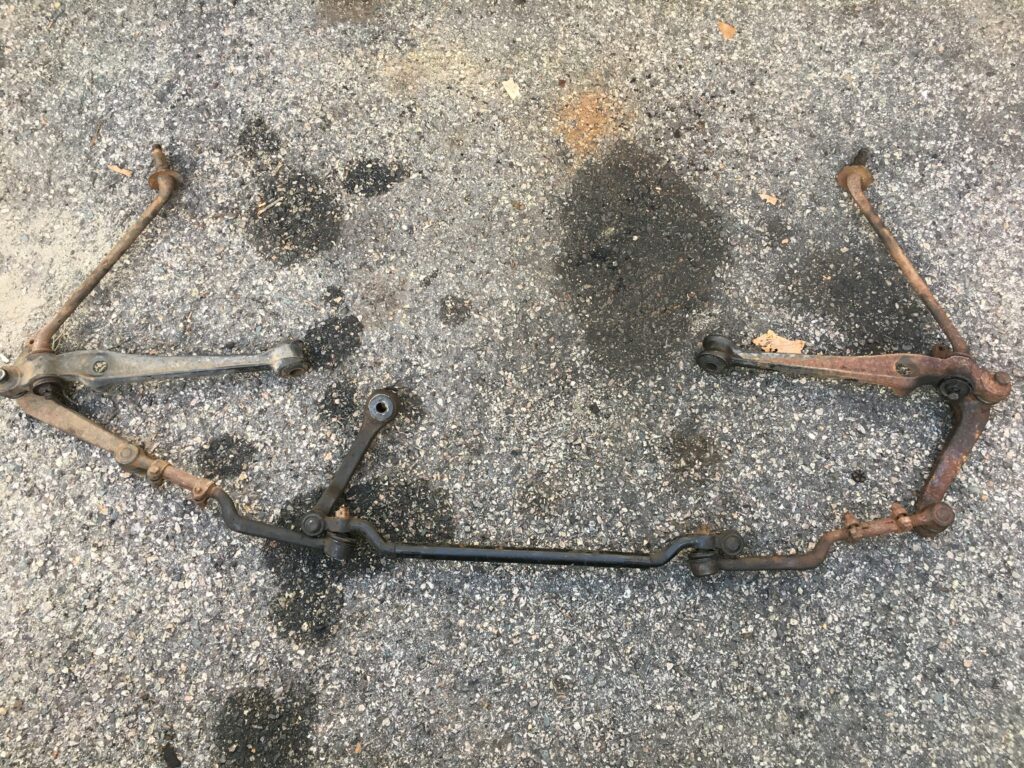
In a world where you never know what parts BMW will see fit to make NLA, I don’t want to throw any of these away.
That just left the steering box. Even after removing the three 17mm bolts holding the box to the subframe, it took quite a bit of prying to break the box away. After all, the two had been mated together since 1971. When it came off, I saw the reason why—three raised metal positioning sleeves.
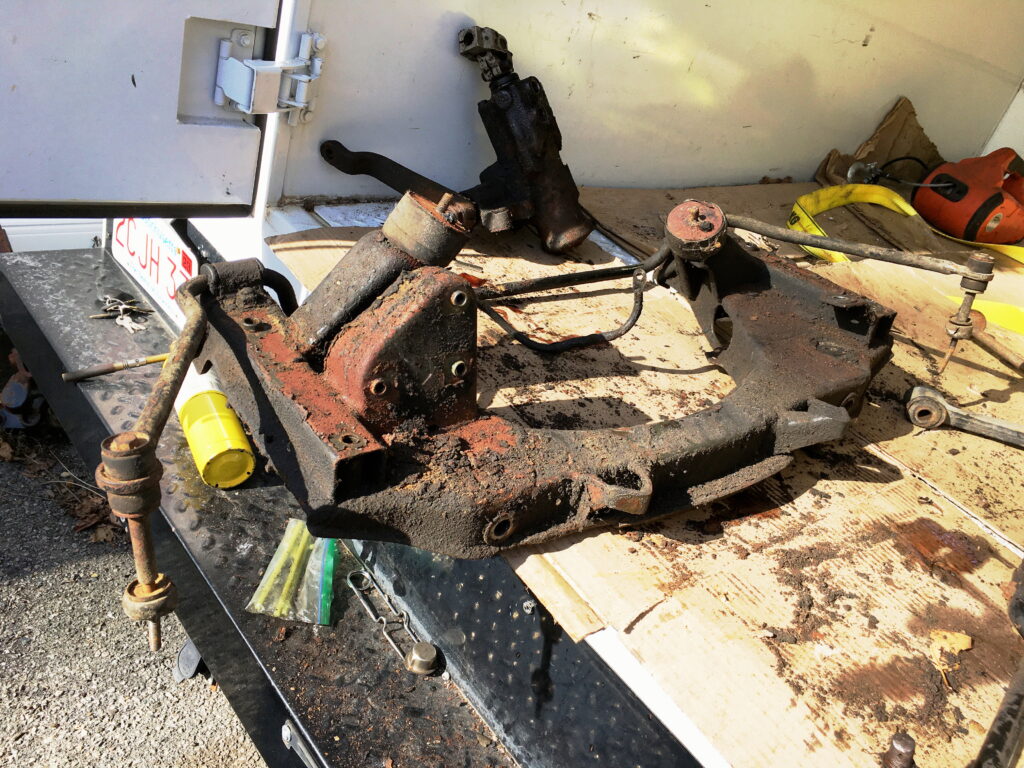
You can see the raised metal sleeves that held the steering box even once the bolts had been removed.
That left just the subframe, two old engine mounts, and the original sway bar. I posted it as free for the taking on the local Nor’East E9er Facebook group, but if there’s a part that’s likely to last the life of a vintage BMW, it’s the front subframe, and thus the demand for them is virtually nonexistent. I offered the two front strut assemblies that were pulled from the same car for free a few years back. I thought there was a good chance someone would grab those, but after a month without takers, they met their fate. Items like this are big and bulky, which make them expensive to ship. Combine that with the microscopic demand and “HOW CAN YOU THROW A PART LIKE THAT AWAY” becomes “Just watch me.” I have other things I need to use the truck for, so gave folks until Saturday morning to claim dibs. No one did. So the subframe I’d saved for 38 years took the half mile ride to the recycling depot.
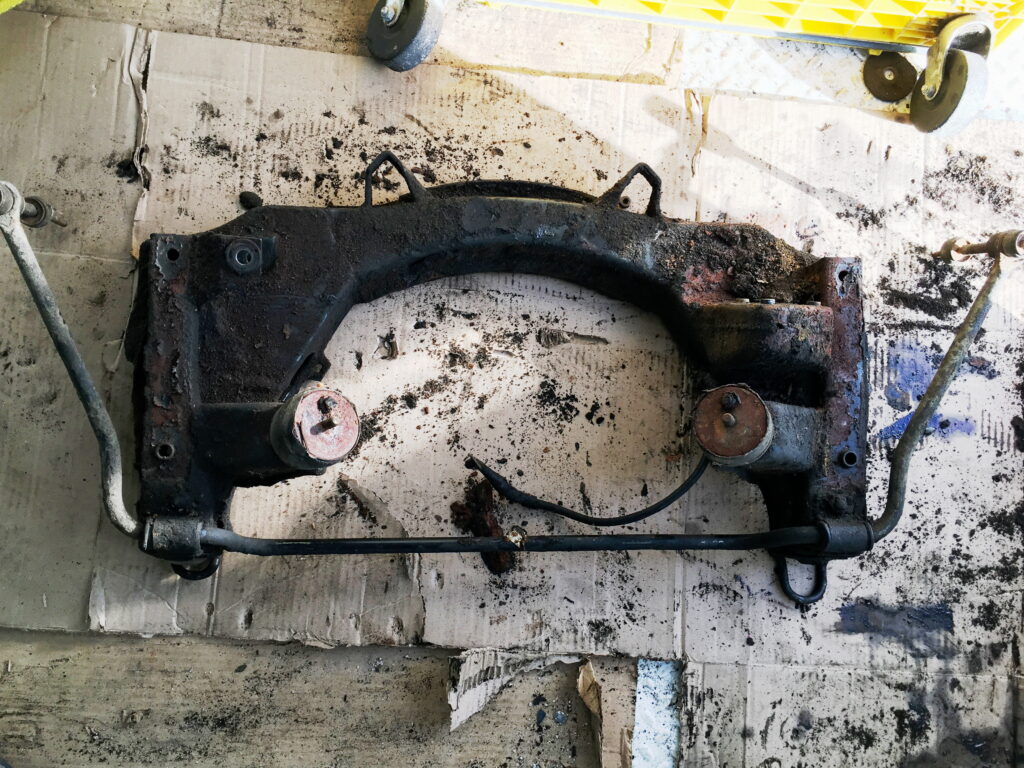
Bye.
Thank heaven it’s not a numbers-matching subframe!
—Rob Siegel
____________________________________
Rob’s newest book, The Best of The Hack Mechanic, is available here on Amazon, as are his seven other books. Signed copies can be ordered directly from Rob here.

